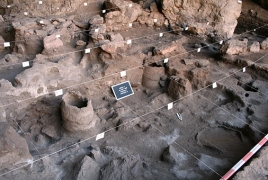Earliest known winery found in Armenia: National Geographic May 4, 2018 - 13:26 AMT PanARMENIAN.Net - As if making the oldest known leather shoe wasn't enough, a prehistoric people in what's now Armenia also built the world's oldest known winery, a new study says, according to National Geographic. Undertaken at a burial site, their winemaking may have been dedicated to the dead—and it likely required the removal of any fancy footwear. Near the village of Areni, in the same cave where a stunningly preserved, 5,500-year-old leather moccasin was recently found, archaeologists have unearthed a wine press for stomping grapes, fermentation and storage vessels, drinking cups, and withered grape vines, skins, and seeds, the study says. "This is the earliest, most reliable evidence of wine production," said archaeologist Gregory Areshian of the University of California, Los Angeles (UCLA). "For the first time, we have a complete archaeological picture of wine production dating back 6,100 years," he said. The prehistoric winemaking equipment was first detected in 2007, when excavations co-directed by Areshian and Armenian archaeologist Boris Gasparyan began at the Areni-1 cave complex. In September 2010 archaeologists completed excavations of a large, 60-centimeter-deep vat buried next to a shallow, 1-meter-long basin made of hard-packed clay with elevated edges. The installation suggests the Copper Age vintners pressed their wine the old-fashioned way, using their feet, Areshian said. Juice from the trampled grapes drained into the vat, where it was left to ferment, he explained. The wine was then stored in jars—the cool, dry conditions of the cave would have made a perfect wine cellar, according to Areshian, who co-authored the new study, published Tuesday, May 1 in the Journal of Archaeological Science. To test whether the vat and jars in the Armenian cave had held wine, the team chemically analysed pottery shards—which had been radiocarbon-dated to between 4100 B.C. and 4000 B.C.—for tell-tale residues. The chemical tests revealed traces of malvidin, the plant pigment largely responsible for red wine's colour. "Malvidin is the best chemical indicator of the presence of wine we know of so far," Areshian said. Ancient-wine expert Patrick E. McGovern, a biomolecular archaeologist at the University of Pennsylvania Museum in Philadelphia, agrees the evidence argues convincingly for a winemaking facility. McGovern called the discovery "important and unique, because it indicates large-scale wine production, which would imply, I think, that the grape had already been domesticated." The number of state universities will be reduced from 23 to 8 by 2030, Minister of Education, Science, Culture and Sport Zhanna Andreasyan has said. From September 21 to November 11, a total of 2,820 Russians registered at a place of residence in Armenia, the police has said. The situation on the contact line between Karabakh and Azerbaijan was relatively stable overnight, the Defense Army says. Defense Minister Suren Papikyan has visited the southern Armenian province of Syunik, the Defense Ministry reported on March 18. Partner news |